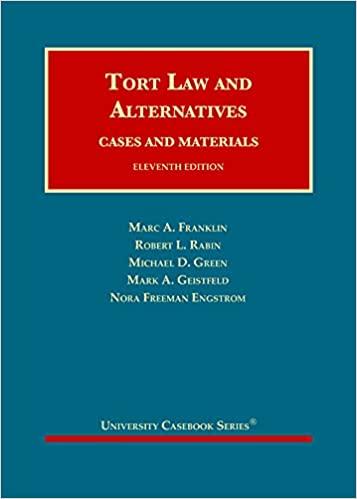Question
Court case: Hagan, Coury & Associates, Brooklyn, N.Y. (Paul Golden of counsel), for appellant. Baker Greenspan & Bernstein, Bellmore, N.Y. (Robert L. Bernstein, Jr., of
Court case:
Hagan, Coury & Associates, Brooklyn, N.Y. (Paul Golden of counsel), for appellant.
Baker Greenspan & Bernstein, Bellmore, N.Y. (Robert L. Bernstein, Jr., of counsel), for respondents.
In an action to recover damages for personal injuries, the plaintiff appeals from an order of the Supreme Court, Queens County (Agate, J.), entered August 22, 2008, which granted the defendants' motion for summary judgment dismissing the complaint.
Ordered that the order is affirmed, with costs.
The plaintiff was standing on a landing on the 10th floor of an interior stairway in the apartment building where she resided when she slipped and fell down part of the staircase leading to the ninth floor. The building in question was owned by the defendant Rochdale Village, Inc., and managed by the defendant Marion Scott Real Estate.
To impose liability on a defendant for a slip and fall on an allegedly dangerous condition on a floor, there must be evidence that the dangerous condition existed and that the defendant either created the condition or had actual or constructive notice of it and failed to remedy it within a reasonable time (see Gordon v American Museum of Natural History,67 NY2d 836 [1986];Moody v Woolworth Co.,288 AD2d 446 [2001]). The plaintiff acknowledged at her deposition that she did not know if there was any water on the landing where she slipped. However, after the accident occurred, she observed that the steps were wet and that there was a puddle of water on a lower landing situated between the 9th and 10th floors. In addition, the plaintiff's pants were saturated after the accident occurred. The plaintiff, however, merely speculated as to the cause of the accident.
The defendants made a prima facie showing of entitlement to judgment as a matter of law by demonstrating that the plaintiff could not identify what caused her to slip and fall. In opposition, the plaintiff failed to raise a triable issue of fact (see Moody v Woolworth Co.,288 AD2d at 447). Therefore, the defendants' motion for summary judgment dismissing the complaint was properly granted. Mastro, J.P., Florio, Eng and Leventhal, JJ., concur.
- What happened?
- Who got injured?
- How did they get injured?
- Who sued whom, and for what, and how much?
- Provide information on the lawsuit/court case
- Which court did the plaintiff file a case in?
- Who won/lost?
- What happened in court - or what was the court's decision?
- Please also identify the particular tort law involved in the case and how tort law applies to or may affect the decisions made by business owners.
- Find the New York statute or rule which addresses the law in question.
- What is a slip and fall, and what are the elements involved to prove a case of slip and fall?
Step by Step Solution
There are 3 Steps involved in it
Step: 1

Get Instant Access to Expert-Tailored Solutions
See step-by-step solutions with expert insights and AI powered tools for academic success
Step: 2

Step: 3

Ace Your Homework with AI
Get the answers you need in no time with our AI-driven, step-by-step assistance
Get Started


